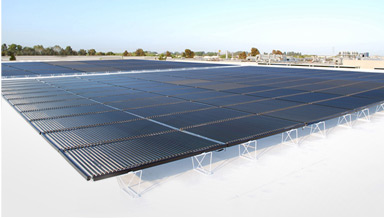As anyone who got stuck in the traffic knows, President Obama made a call at one of the Bay Area’s new darlings of green tech, Fremont-based Solyndra Inc., which he called a “testament to American ingenuity and dynamism.”
The firm is tapping more than a half-billion dollars in federal loan guarantees to build a manufacturing plant for its photovoltaic (PV) technology. Governor Schwarzenegger and Energy Secretary Steven Chu have also used Solyndra as a backdrop for showcasing California’s burgeoning clean tech sector. The company has developed a new type of PV technology designed for commercial rooftops.

Today in Silicon Valley, the big, green hype machine was running at full tilt. Solyndra’s CEO, Chris Gronet, talked up the California location. “If our factory was someplace else (outside the US), we probably would not have the supply chain across 29 US states,” he told KQED’s Cy Musiker today.
Mike Mielke of Silicon Valley Leadership Group added to the frenzy: “Clearly California’s leadership in the emerging trillion-dollar clean energy technology market has put us in an ideal investment position,” he said in a statement issued after the Presidential appearance. “We would not be as competitive without the state’s landmark clean energy policies like AB 32.”
But some temperance was injected into the festivities by Severin Borenstein, co-director of the Energy Institute at UC Berkeley’s Haas School of Business. Asked if investments in solar panel production necessarily translate to permanent job growth, he told Musiker: “The evidence from a longer-run perspective really doesn’t support that.”
Borenstein says what history does demonstrate is that dominance in a given technology lasts just about as long as the government subsidies supporting it. He pointed to both Germany and Spain, both of which have recently lost some of their edge in production of solar components. Much production of solar and wind energy products has already moved to China.
“This idea that you’re going to create a permanent competitive advantage in producing green technology by subsidizing it now is really not very well born out in the data,” said Borenstein, who doesn’t deny that federal stimulus funding has “helped push forward” some key technologies. In the absence of a meaningful price mechanism for carbon emissions, Borenstein says that “pushing forward on some of these alternative technologies is the best thing we can do.”
Regarding California’s landmark climate law, the aforementioned AB 32, Borenstein agrees with the state’s Legislative Analyst that implementation would not have a significant impact on California’s overall economy, in either direction. But Borenstein doesn’t see the point in abandoning the state’s primary comprehensive climate strategy to save jobs, as some have suggested it would. “Climate change is real and it is potentially catastrophic,” said Borenstein. “If every time we have an economic setback, we put the environment second, we’re never going to make any progress.”
One thought on “The Solar Jobs Solution: Some Perspective”
Comments are closed.

Craig,
Thanks for the insightful report. Long term green jobs, without government subsidies, are myth. Mother Nature will soon take care of the climate change with some long term cooling.